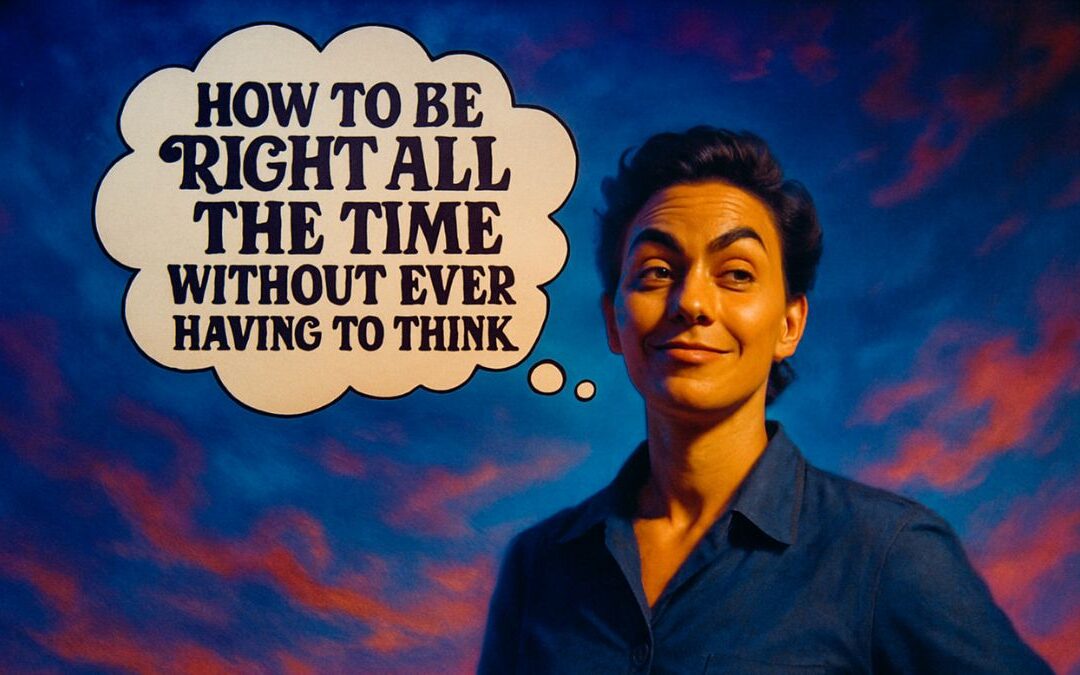The Ghost in the Machine
There’s a specter haunting the modern workplace. It whispers in boardrooms, it hums in the server farms, and it’s the unspoken subtext of a thousand articles about the future of work. That specter is automation. We’re told that the robots are coming for our jobs, that artificial intelligence will soon be able to do everything from drafting legal documents to diagnosing diseases. And in many ways, this is true. The predictable, the repetitive, the rule-based—all these tasks are gradually being ceded to the machine.
This reality has cleaved the world of work into two distinct categories: the tasks that can be automated, and the tasks that, for now, cannot. And in that second category lies the single most valuable, most sought-after, and most uniquely human skill in the 21st-century economy: critical thinking.
When employers list “critical thinking” on a job description, they’re not asking for someone who is perpetually negative or who enjoys picking fights in meetings. They are signaling a desperate need for something that no algorithm can yet replicate. They are looking for people who can navigate ambiguity, solve novel problems, challenge outdated assumptions, and make reasoned judgments in a fog of incomplete information. They are looking for the ghost in the machine—the spark of human consciousness that can analyze, synthesize, and create, not just calculate.
This article is about that spark. We’re going to explore why this ancient skill has become the paramount asset in your career toolkit. We’ll examine, with real-world scenarios, how it fuels the innovation that keeps companies alive, how it underpins the strategic decisions that make or break them, and why it’s the non-negotiable lynchpin of effective leadership. And most importantly, we’ll move from the theoretical to the practical, offering concrete advice on how you can cultivate and, crucially, demonstrate this skill to the people who have the power to hire and promote you.
The Automation-Proof Skill: Why Robots Can’t (Yet) Steal Your Judgment
For decades, we’ve been fed a vision of the future where intelligent machines would handle the high-level thinking while humans were relegated to more menial tasks. The reality has turned out to be the precise opposite. AI and automation are proving to be brilliant at menial cognitive tasks, but they are still profoundly inept at true thinking.
From Repetition to Reasoning
An AI can analyze a million spreadsheets in the time it takes you to brew a cup of coffee. It can identify patterns in data sets so vast that a human mind could never comprehend them. It can execute any task that follows a clear set of rules with flawless, tireless precision. What it can’t do is understand context. It can’t grasp irony. It can’t make an ethical judgment call when two rules conflict. It can’t sit with a client, read their body language, and understand the problem they aren’t telling you about.
This is the fundamental difference between processing and thinking. An algorithm can process what is there; it cannot reason about what is not there. It can follow the map; it cannot explore the uncharted territory. The World Economic Forum, in its “Future of Jobs” report, consistently places skills like “analytical thinking and innovation” and “complex problem-solving” at the very top of the list of skills employers will need most in the coming years. Why? Because as routine tasks are automated, the work that is left for humans is, by definition, the non-routine. It is the complex, the ambiguous, and the strategic.
The Market Demands a Mind
Think about it this way: a company can now automate large parts of its accounting, its data entry, and even its customer service chatbots. The value of an employee who can simply perform these tasks by rote has plummeted. But the value of the employee who can interpret the output of those automated systems, who can ask, “The data is showing a strange trend in customer complaints, I wonder what’s causing that at a deeper level?”—that value has skyrocketed.
The market is no longer paying a premium for human calculators or human filing cabinets. It’s paying a premium for human judgment. And the structured, disciplined process of arriving at a sound judgment is the very definition of critical thinking.
The Innovation Engine: How Questioning the Status Quo Creates Value
Every company has a set of sacred truths. “This is how we’ve always done it.” “Our customers would never go for that.” “That’s not how our industry works.” These statements are the bars of a cage, and the five most dangerous words a critical thinker can utter are the key: “Why do we do it this way?”
“Why Do We Do It This Way?” – The Most Profitable Question
Innovation is rarely the product of a single, brilliant “eureka!” moment. More often, it is the result of a systematic deconstruction of assumptions. Consider the case of Blockbuster versus Netflix. Blockbuster’s entire business model was built on a core assumption: people will happily drive to a store to rent a movie and will tolerate punitive late fees. This was the unquestioned status quo.
Netflix’s founders engaged in an act of profound critical thinking. They asked, “Why must a video store have physical locations? Why must the revenue model be based on punishing customers with late fees?” They challenged the fundamental dogma of the industry. Their first innovation, DVDs by mail, was a direct answer to those questions. Their second, even bigger innovation—streaming—obliterated the entire concept of a “rental” and the very idea of a “late fee.” Blockbuster, unable or unwilling to question its own foundational assumptions, saw its multi-billion dollar empire crumble into dust. The difference wasn’t technology; it was a willingness to think critically about “the way things are done.”
This plays out on a smaller scale every single day. The marketing manager who questions why the budget is always allocated the same way every year might discover a massive, untapped digital audience. The engineer who asks why a product has to have a certain feature might find that removing it makes the product cheaper, simpler, and more appealing to a different customer segment. Innovation is a function of inquiry.
Connecting the Unconnected Dots
Another facet of critical thinking is synthesis—the ability to combine disparate ideas or pieces of information to create something new. A non-critical thinker sees data in silos: here are the sales figures, here is the customer feedback, here is the competitor analysis. A critical thinker looks for the invisible threads that connect them.
They might notice that a slight dip in sales in one region correlates with a specific complaint that keeps popping up in customer reviews, and that a new feature from a competitor seems designed to address that very complaint. The data points are just noise on their own. The synthesis of those points into a coherent narrative—”I believe we’re losing market share because of this specific design flaw, and our competitor is exploiting it”—is an act of high-level critical thought. This ability to see the whole chessboard, not just the individual pieces, is what separates a mere functionary from a true strategist.
The Strategist’s Compass: Making Decisions in a Fog of Data
We live in an age of “big data,” and we’re often told that data-driven decision-making is the key to success. This is only half-true. Data can give you a wonderfully precise picture of the past, but it cannot, on its own, tell you what to do next. Data is the raw material; critical thinking is the forge.
Beyond the Spreadsheet
A spreadsheet can tell you that a certain product’s sales are down 15%. This is a fact. But it can’t tell you why. Is it a pricing issue? A quality problem? A new competitor? A shift in consumer taste? Has our marketing become stale? The data provides the “what.” The critical thinker’s job is to relentlessly pursue the “why,” the “so what,” and the “now what.”
This involves interrogating the data itself. Is this data reliable? What biases might be baked into how it was collected? Are we looking at correlation or causation? A non-critical thinker takes the data at face value. A critical thinker cross-examines it like a hostile witness. They supplement the quantitative data with qualitative insights—talking to customers, getting feedback from the sales team, understanding the broader market context. They understand that the most important factors in a decision are often the ones that can’t be neatly quantified.
The Pre-Mortem: Killing Your Bad Ideas Before They Cost You
One of the most powerful and practical critical thinking exercises for strategic planning is the “pre-mortem.” It’s simple but profound. Before embarking on a major project or initiative, the team gathers and imagines that it is one year in the future, and the project has failed spectacularly. It has been a complete and utter disaster. Then, each person takes a few minutes to write down every reason they can think of for why it failed.
This simple reframing is psychological magic. Instead of the usual optimism-driven brainstorming that can suffer from groupthink, it liberates people to voice doubts and concerns without seeming negative or disloyal. It forces the team to anticipate potential threats, to identify hidden assumptions, and to see the project’s weaknesses from the outset. By critically analyzing the plan from the perspective of its future failure, you can often spot and fix the fatal flaws before you’ve invested a single dollar or a single hour of work. It is the institutionalization of proactive skepticism.
The Leadership Lynchpin: It’s Not About Having the Answers
The traditional model of a leader is the hero who has all the answers, the brilliant commander who stands on a hill and directs the troops. This model is obsolete. In a complex, rapidly changing world, no single person can have all the answers. The role of the modern leader is not to be the smartest person in the room, but to create an environment where the collective intelligence of the team can flourish. And that requires making critical thinking the cornerstone of the team’s culture.
From Command and Control to Conscious Inquiry
An effective modern leader manages the thinking process of their team. They don’t say, “Here’s the plan; go execute it.” They say, “Here’s the problem we’re facing. What are our assumptions? What data do we have? What are the possible ways we could approach this? What are the risks of each approach?”
They lead with questions, not directives. They act as a facilitator of debate, a challenger of assumptions (including their own), and a synthesizer of the team’s disparate viewpoints. They understand that their job is to get the best thinking from every single person on the team. This requires humility and the confidence to not have the final word. It’s a shift from leadership as a monologue to leadership as a well-moderated Socratic dialogue.
Fostering a Culture of Psychological Safety
You cannot have a culture of critical thinking without a culture of psychological safety. Full stop. If people are afraid that they will be punished, shamed, or marginalized for pointing out a flaw in a plan, for challenging their boss’s idea, or for admitting a mistake, they will stop doing it. They will retreat into a perfunctory silence, nodding along in meetings while keeping their valuable insights to themselves.
A true leader knows that dissent is not a sign of disrespect; it is a sign of engagement. They actively solicit contrarian viewpoints. They celebrate the person who plays devil’s advocate. When a mistake is made, their first question is not “Who is to blame?” but “What can we learn from this so we don’t repeat it?” They create a “lab” environment where hypotheses can be tested, where failure is a data point, and where intellectual honesty is the highest virtue. In such an environment, critical thinking isn’t just a skill; it’s the air everyone breathes.
Marketing Your Mind: Showcasing Critical Thinking to Employers
It’s one thing to possess this skill; it’s another thing entirely to convince a potential employer that you have it. You can’t just write “I’m a critical thinker” on your resume and expect anyone to believe you. You have to prove it. You have to make your critical thinking visible in your application materials and your interviews.
Your Resume is an Argument, Not a List
Most resumes are boring. They are a passive list of job duties. “Responsible for managing social media accounts.” “Tasked with preparing weekly reports.” This tells a hiring manager what you were assigned to do, not what you actually accomplished or how you thought.
Reframe your resume as an argument, and every bullet point as a piece of evidence for the thesis that “I am a valuable problem-solver.” Instead of listing duties, describe your impact using a simple “Problem-Action-Result” (PAR) or “Challenge-Action-Result” (CAR) framework.
- Instead of: “Managed the company blog.”
- Try: “Analyzed stagnant blog traffic (Problem), developed and implemented a new content strategy based on SEO and audience analytics (Action), resulting in a 150% increase in organic readership in six months (Result).”
- Instead of: “Responsible for customer service.”
- Try: “Identified a recurring customer complaint that was driving churn (Problem), proposed a streamlined workflow for the support team (Action), which reduced average ticket resolution time by 40% and improved customer satisfaction scores by 15% (Result).”
Notice the verbs: analyzed, developed, identified, proposed. These are the verbs of a thinker and a doer, not a passive functionary.
Answering the Unspoken Question in Interviews
In any behavioral interview, when an employer asks, “Tell me about a time when you faced a difficult challenge,” the unspoken part of the question is, “…and show me how you thought your way through it.”
The STAR method (Situation, Task, Action, Result) is your best friend here. It provides a structure for telling a compelling story that showcases your thought process.
- Situation: Briefly set the context. “In my previous role, we were facing declining engagement with our flagship product.”
- Task: Describe your specific responsibility. “My task was to diagnose the root cause of the decline and propose a solution.”
- Action: This is the most important part. Don’t just list what you did; explain why you did it. This is where you reveal your critical thinking. “First, I resisted the initial assumption that it was a pricing issue. I started by synthesizing three different data sources: user analytics, customer support tickets, and direct interviews with churned users. The data suggested the problem wasn’t price, but a confusing user interface introduced in the last update. Based on this analysis, I worked with the UX team to develop and A/B test a simplified design.”
- Result: Quantify your impact. “The new design was rolled out, and over the next quarter, we saw a 20% increase in user engagement and a 50% reduction in negative support tickets related to that feature.”
This answer doesn’t just say you’re a critical thinker; it walks the interviewer through a live-action demonstration of your skills in analysis, synthesis, and problem-solving.
The Active Mind
In the end, critical thinking is not a credential you earn or a personality trait you’re born with. It is an active, disciplined, and courageous process. It’s the discipline to resist easy answers and gut feelings. It’s the humility to recognize the limits of your own knowledge and the biases that shape your thinking. And it’s the courage to ask the difficult questions, to challenge the comfortable consensus, and to speak your reasoned truth, even when it’s unpopular.
The future of valuable work will not be about how well you can follow a script, but about how well you can write a new one when the old one is no longer working. It will be about your ability to solve the problems that don’t have a manual. As automation and AI consume the world of the predictable, they are leaving behind a world of immense opportunity for those who can think. In this new world, your mind is not just your greatest asset; it’s your last, best competitive advantage. Hone it. Trust it. And learn to show it off.
Focus on Language
Vocabulary and Speaking
Alright, let’s zoom in on some of the language from that article. Choosing the right words in a professional context is crucial. It can make the difference between sounding like you’re just repeating buzzwords and sounding like you genuinely understand the concepts you’re talking about. We’re going to break down ten words and phrases that can add precision and power to your professional vocabulary. The goal here isn’t to just memorize them, but to get a feel for their nuance so you can deploy them confidently in meetings, emails, and interviews. Let’s start with a word I used right in the introduction: paramount. I said that critical thinking has become the “paramount asset” in your career. Paramount means more important than anything else; supreme. It’s a step above “very important.” When you say something is paramount, you’re signaling that it’s the absolute top priority, the thing that everything else depends on. In a business negotiation, you might say, “While price is important, ensuring the quality of the materials is paramount.” It clearly establishes your non-negotiable priority. You could tell your team, “In this project, meeting the deadline is paramount.” Everyone immediately understands the supreme importance of that one goal.
Next, let’s look at status quo. The article mentions that innovation often comes from questioning the “status quo.” The status quo is the existing state of affairs, especially regarding social or political issues. In a business context, it’s “the way things are now” or “the way we’ve always done it.” It’s a Latin phrase that has been fully absorbed into English. Questioning the status quo is at the heart of progress. A new CEO might say, “My goal is not to maintain the status quo, but to challenge it and find new avenues for growth.” If a colleague is resistant to a new idea, you could gently say, “I understand the comfort of the status quo, but I think this change could bring significant benefits.” It’s a formal and effective way to talk about the current, established way of doing things.
We also talked about navigating ambiguity. Critical thinkers are comfortable with ambiguity, which is the quality of being open to more than one interpretation; inexactness. In the workplace, you’re almost never dealing with perfect, complete information. A new market is full of ambiguity. A client’s request might be deliberately ambiguous. Someone who needs everything to be black and white will be paralyzed in these situations. A critical thinker thrives in ambiguity, seeing it as an opportunity to ask questions, gather more information, and forge a path forward. You could say in an interview, “I’m very comfortable with ambiguity; in my last role, I was often tasked with projects that had unclear goals, and I enjoyed the process of defining the strategy.”
This leads perfectly to synthesis. Critical thinking involves the “synthesis of those points into a coherent narrative.” Synthesis is the combination of components or elements to form a connected whole. It’s the opposite of analysis, which is breaking something down. After you’ve analyzed all the data (broken it down), you need to synthesize it (put it back together) to form an insight or a conclusion. A good strategist can take disparate pieces of information—market trends, competitor actions, internal data—and create a synthesis that reveals a new opportunity. You could praise a colleague by saying, “Her great skill is synthesis; she can listen to three different arguments in a meeting and combine the best parts of each into a brilliant solution.”
The information a good thinker synthesizes is often disparate. I mentioned combining “disparate ideas.” Disparate means essentially different in kind; not allowing comparison. It’s a strong word to emphasize that things are truly unalike. You’re not just combining similar ideas; you’re finding connections between things that no one else saw were related. Steve Jobs’s famous synthesis of calligraphy, technology, and design to create the Macintosh was a combination of disparate fields. In a business context, you might say, “Our team is made up of people from disparate backgrounds—engineering, marketing, and art history—which is why our brainstorming sessions are so creative.”
Now for a word that describes a crucial role: lynchpin. The article calls effective leadership the “non-negotiable lynchpin” of a thinking culture. A lynchpin is a person or thing vital to an enterprise or organization. Literally, it’s the pin that goes through the end of an axle to keep a wheel from coming off. If you remove the lynchpin, the whole cart collapses. Metaphorically, it’s the one piece that holds everything together. You could say, “Our head of research is the lynchpin of our innovation department.” Or, “Customer trust is the lynchpin of our entire brand.” It’s a powerful metaphor to describe something or someone absolutely essential.
Let’s look at a word that describes the opposite of critical thinking: perfunctory. The article warns against retreating into a “perfunctory silence” in meetings. A perfunctory action is one carried out with a minimum of effort or reflection. It’s going through the motions. When you ask a disengaged employee for their opinion and they give a vague, non-committal answer, that’s a perfunctory response. A perfunctory safety check is one where you just tick the boxes without actually looking at anything. It implies a lack of care, interest, and thought. You might complain, “He gave my proposal a perfunctory glance and then dismissed it. I don’t think he even read it.”
Another word for a limited way of thinking is myopic. A non-critical thinker can often be myopic, which literally means nearsighted, but is used metaphorically to mean lacking imagination, foresight, or intellectual insight. A myopic focus on quarterly profits might cause a company to cut research and development, dooming its long-term future. A myopic view of a problem is one that fails to consider the broader context or long-term consequences. You could argue in a strategy meeting, “We need to avoid a myopic approach. While this solution solves the immediate problem, it will create bigger issues for us down the road.”
Let’s look at a verb that is key to leadership: incentivize. A good leader knows how to incentivize the behaviors they want to see. To incentivize something is to provide someone with a reason for doing something; to motivate them with a potential reward. Companies incentivize sales by offering commissions. They might incentivize innovation by offering bonuses for new patents. The incentive doesn’t have to be monetary. A leader can incentivize intellectual risk-taking by publicly praising people who challenge the status quo, even if their ideas aren’t adopted. It’s a core concept in management and economics. “How can we incentivize our teams to collaborate more effectively across departments?” is a classic leadership question.
Finally, let’s touch on the word prognosticate. This is a more formal and impressive word for “predict” or “forecast.” To prognosticate is to foretell or prophesy a future event. While data can describe the past, a strategist’s job is to use that data to prognosticate about future trends. Weather forecasters prognosticate about the weather. Financial analysts prognosticate about the stock market. It implies a forecast that is based on analysis and evidence, not just a wild guess. You might say, “It’s difficult to prognosticate the long-term effects of this new technology, but we can identify some likely trends.”
There you have it. Ten words that can elevate your professional communication. Now, how do we put them into practice?
Our speaking lesson for today is structuring a persuasive argument in a high-stakes meeting. It’s one thing to have a good idea; it’s another to present it in a way that gets people to listen and take you seriously. A common mistake is to just state your opinion. A better way is to build a logical case. A simple and powerful structure is the “What? So What? Now What?” framework.
- What? State the key fact or observation. This is the objective reality. “The latest data shows that our customer acquisition cost has increased by 30% this quarter.”
- So What? Explain why it matters. This is the synthesis, the interpretation. This is where you connect the dots and explain the implication or the threat. “The so what is that this trend is unsustainable. At this rate, our marketing budget will be depleted by Q3, and we will miss our annual growth targets. This isn’t a minor fluctuation; it’s a threat to the status quo of our growth model.”
- Now What? Propose a clear, actionable next step. This is your recommendation. “The now what is that I propose we form a small task force to do a deep-dive analysis. Instead of a perfunctory review, we need to understand the root cause. I suggest we analyze the performance of each marketing channel to see if we can identify the source of the inefficiency.”
See how that works? It’s logical, evidence-based, and it moves from problem to solution.
Here is your speaking challenge. Imagine you are in a meeting. A colleague makes the following statement: “We should enter the new market in Country X immediately. Our competitor is already there.” Your gut feeling is that this is a rushed, myopic decision. Your assignment is to formulate a response using the “What? So What? Now What?” framework. Your goal is to persuade the team to be more cautious and analytical without sounding negative. Try to use at least three of our vocabulary words: paramount, status quo, ambiguity, synthesis, disparate, lynchpin, perfunctory, myopic, incentivize, prognosticate. Record yourself saying it out loud. Does it sound compelling? Does it command respect? This framework is a tool to structure your critical thinking on the fly, making you a more persuasive and effective communicator in any professional setting.
Grammar and Writing
Let’s carry this focus on persuasive communication over to your writing. The single most important piece of writing in your job search is your cover letter. It’s your opening argument, your chance to frame the narrative of your career before the interviewer even sees your resume. A generic, boring cover letter is a missed opportunity. A great one can make you the must-hire candidate.
The Writing Challenge:
Find a real job posting that you are genuinely interested in and qualified for. Write a cover letter (400-500 words) specifically for this role. Your challenge is to go beyond simply listing your skills and experiences. The goal is to write a compelling narrative that demonstrates your critical thinking ability. Use your past experiences as case studies to prove that you are the problem-solver they are looking for.
This is a high-stakes writing task, so let’s equip you with the grammatical and stylistic tools to make it a success.
Tip 1: Make the First Paragraph About Them, Not You
Most cover letters start with a thud: “I am writing to apply for the position of [Job Title] which I saw advertised on [Platform].” This is a waste of prime real estate. The hiring manager knows what you’re applying for. Your first paragraph should show that you understand their problem. You need to demonstrate that you’ve thought critically about their needs.
- Weak Opening (All about you): “I have five years of experience in marketing and I believe my skills are a good fit for your team.”
- Strong Opening (About them): “As a market leader in the competitive fintech space, [Company Name] constantly faces the challenge of acquiring new users while maintaining a strong brand identity. My experience in developing data-driven marketing strategies that directly addressed stagnant growth at my previous company aligns perfectly with the strategic needs of this role.”
The strong opening does a few things: It shows you’ve done your research on the company and their industry. It identifies a likely challenge they face. And it immediately connects your key accomplishment to their need.
Grammar Focus: Active Voice and Strong Verbs
This is the single most important grammatical rule for career-related writing. Your resume and cover letter must be written in the active voice. Active voice is when the subject of the sentence performs the action. Passive voice is when the subject is acted upon.
- Passive: “The marketing strategy was re-engineered by me.” (Weak, indirect)
- Active: “I re-engineered the marketing strategy.” (Strong, confident, direct)
Passive voice sounds evasive and weak. Active voice makes you sound like a dynamic person who takes initiative. To ensure you’re using active voice, start your sentences and bullet points with strong, action-oriented verbs.
Don’t just say you’re a critical thinker; use the verbs of critical thinking. Instead of “Was responsible for…,” try:
- Analyzed complex datasets to identify key trends.
- Synthesized customer feedback and sales data to inform product development.
- Re-engineered an inefficient workflow to reduce costs by 20%.
- Forecasted market shifts to proactively adjust our strategy.
- Optimized the sales funnel, leading to a 15% increase in conversion.
- Diagnosed the root cause of a recurring technical issue.
- Formulated a new policy that resolved inter-departmental conflicts.
Using these powerful, active verbs is the grammatical equivalent of making eye contact and having a firm handshake.
Tip 2: Structure the Body Paragraphs as “Mini-Stories”
Don’t just list skills like “problem-solving” or “strategic thinking.” Prove them. Use the body of your cover letter to tell one or two concise stories using the STAR (Situation, Task, Action, Result) or PAR (Problem, Action, Result) method we discussed earlier.
“In my role as Project Manager, our team was tasked with launching a new software feature. However, we were faced with a significant problem: early testing revealed a perfunctory and confusing user onboarding process that was causing high drop-off rates. My immediate action was to propose a two-week pause on development to conduct a rapid series of user interviews. I synthesized this disparate feedback and discovered the myopic assumption we had made about our users’ technical knowledge. Based on this analysis, I led the redesign of the onboarding flow. The result was a successful launch where new user retention in the first week exceeded our targets by 30%.”
This paragraph doesn’t just say you’re a problem solver; it walks the reader through your thought process, using our vocabulary words to add richness and precision.
Grammar Focus: Using Subordinating Conjunctions to Show Cause and Effect
To make your stories more compelling, you need to show the logical connections between your actions and the results. Subordinating conjunctions are the grammatical glue that does this. Words like because, since, so that, in order to, as a result of, and due to are essential for explaining your reasoning.
- Simple: “I implemented a new system. It saved the company money.”
- Complex (Better): “I implemented a new system so that we could automate perfunctory tasks. As a result, the company saved over $50,000 annually in labor costs.”
- Simple: “We paused the project. We wanted to get more user feedback.”
- Complex (Better): “Because early testing revealed a critical flaw, we paused the project in order to gather more user feedback and avoid a costly failure at launch.”
Using these conjunctions forces you to explain your “why,” which is the very essence of demonstrating critical thought.
Tip 3: End with a Confident, Forward-Looking Statement
Your final paragraph should reiterate your value and propose the next step.
- Weak Ending (Passive): “I have attached my resume for your consideration. I hope to hear from you soon.”
- Strong Ending (Confident): “I am confident that my ability to analyze problems and execute data-driven solutions can bring significant value to your team. I am eager to discuss how my experience in [mention a specific skill from the job description] can help [Company Name] achieve its goals. I am available for an interview at your earliest convenience.”
This ending expresses confidence, directly links your skills to their goals, and takes initiative by suggesting the next step. It’s the closing argument to the case you’ve just built.
By combining a “them-first” approach, a narrative structure, and the grammatical power of active voice and logical conjunctions, your cover letter will transform from a simple application into a compelling demonstration of your critical mind at work.
Let’s Discuss
- The “Critical Thinker” vs. “The Team Player”: The article celebrates the person who asks, “Why do we do it this way?” In many corporate cultures, however, this person can be labeled as “not a team player,” “disruptive,” or “negative.” How can an individual effectively use critical thinking to drive positive change without being marginalized? What responsibility does leadership have in distinguishing between constructive dissent and unhelpful negativity?
- The Resume Paradox: The article gives advice on phrasing resume bullet points to showcase critical thinking (e.g., “Analyzed X to achieve Y”). Given that many initial resume screenings are done by AI (Applicant Tracking Systems) looking for specific keywords, is there a risk that this more narrative, analytical language will be missed by the bots? How should job seekers balance writing for a human reader versus writing for an algorithm?
- Analysis Paralysis: The article positions critical thinking as an engine of progress. But can a culture that over-emphasizes critical analysis fall into “analysis paralysis,” where decisions are endlessly debated and action is never taken? In what types of industries or situations might a “good enough” decision made quickly be superior to a “perfect” decision made slowly?
- Can Critical Thinking Be Taught? We often talk about critical thinking as a skill to be hired, but can it be effectively taught to an existing workforce? If so, what does that training look like? Is it a series of workshops, a change in management style, or something deeper? Can a person who is not naturally inclined to be skeptical and analytical truly learn to be a critical thinker, or are we just teaching them to mimic the behaviors?
- The Ethics of “Good” Thinking: A brilliant critical thinker can analyze a system, identify its weaknesses, and devise a strategy for success. But what if the goal is ethically questionable? For example, a team could use critical thinking to devise a highly effective, but manipulative, advertising campaign. Is critical thinking a morally neutral tool, or does true critical thinking have to include an ethical or moral component?
- The Lonely Innovator Myth: The article uses the Netflix vs. Blockbuster example, which can feed into the “lone genius” myth of innovation. In reality, large-scale innovation is a team sport. How does critical thinking function at a group level? What are the dynamics of a team that thinks critically together, and what processes (like the pre-mortem) can help a group avoid the pitfalls of groupthink?
- Automation as a Catalyst: The article frames automation as a threat that makes critical thinking valuable. Could we reframe this? Could automation and AI be seen as powerful tools that enhance our critical thinking? For example, by letting AI handle the massive data analysis, are we freeing up human brainpower to focus exclusively on the higher-level tasks of synthesis, strategy, and creative problem-solving? How can we best partner with technology to augment our own thinking?
Critical Analysis
The article does a compelling job of framing critical thinking as the premier career asset in an age of automation. It effectively connects the skill to innovation, strategy, and leadership, and provides solid, actionable advice for job seekers. However, from an expert perspective, the piece operates on a few optimistic assumptions and overlooks some of the grittier, more complex realities of corporate life.
First, the article places the burden of critical thinking almost entirely on the individual employee. It’s presented as a personal skill to be developed and marketed. This drastically underestimates the power of organizational culture. An individual can be the most brilliant critical thinker in the world, but if they work in a hierarchical, fear-based culture, exercising that skill becomes a surefire way to get sidelined. True critical thinking—the kind that involves challenging the status quo and pointing out uncomfortable truths—is often a politically risky act. The article mentions “psychological safety” in the leadership section, but it deserves to be a central theme. The reality is that many, if not most, organizations are not designed to reward genuine critical thought; they are designed to reward compliance and predictability. The unwritten rule is often “bring me solutions, not problems,” which actively discourages the diagnostic part of critical thinking.
Second, the article draws a very clean line between the analytical side of critical thinking and other “soft skills.” In reality, emotional intelligence (EQ) is an inseparable component of effective critical thinking in a professional context. You can have the most brilliant, data-driven analysis of why a project is doomed to fail, but if you present that analysis in a way that shames your colleagues or makes your boss feel incompetent, your brilliant insight will be dead on arrival. The ability to read the room, to frame a critique constructively, to build consensus, and to persuade with empathy is what translates critical thought into actual change. The article focuses on the “what” of the analysis but largely ignores the “how” of its delivery, which is often the more difficult part.
Third, a major piece of the puzzle is largely absent: a deep dive into the psychology of cognitive biases. The article operates as if critical thinking is simply a matter of applying a rational process. But the primary enemy of critical thinking isn’t a lack of process; it’s our own inherently biased, shortcut-loving brains. In a corporate setting, you see these biases everywhere: the sunk cost fallacy (“We’ve invested too much in this project to stop now, even though it’s failing”), confirmation bias (“Let’s only look at the data that supports the decision we’ve already made”), and groupthink (“Everyone else in the meeting seems to agree, so I won’t voice my concerns”). A more robust analysis would emphasize that a key part of critical thinking is metacognition—thinking about your own thinking—and actively developing systems and habits (like the pre-mortem, or assigning a devil’s advocate) to counteract these predictable mental traps.
Finally, the article doesn’t fully confront the difficulty in assessing critical thinking. It’s easy for employers to say they want it, but it’s incredibly difficult to measure. This leads companies to rely on proxies, such as the prestige of a candidate’s university or their GPA. This can create a system that favors those with privileged educational backgrounds rather than those who have demonstrated the skill in different environments. The interview advice given is sound, but it assumes an interviewer who is skilled at listening for and recognizing critical thought. Often, interviewers are just as susceptible to bias, favoring confident speakers over thoughtful ones. The systemic challenge of how we accurately identify and cultivate this skill, beyond simply listing it on a job description, remains a massive, unresolved issue.
In short, while the article provides an excellent “what” and “why,” a deeper analysis reveals that the “how” is tangled up in the complex, often irrational, and politically charged realities of organizational life and human psychology.











0 Comments